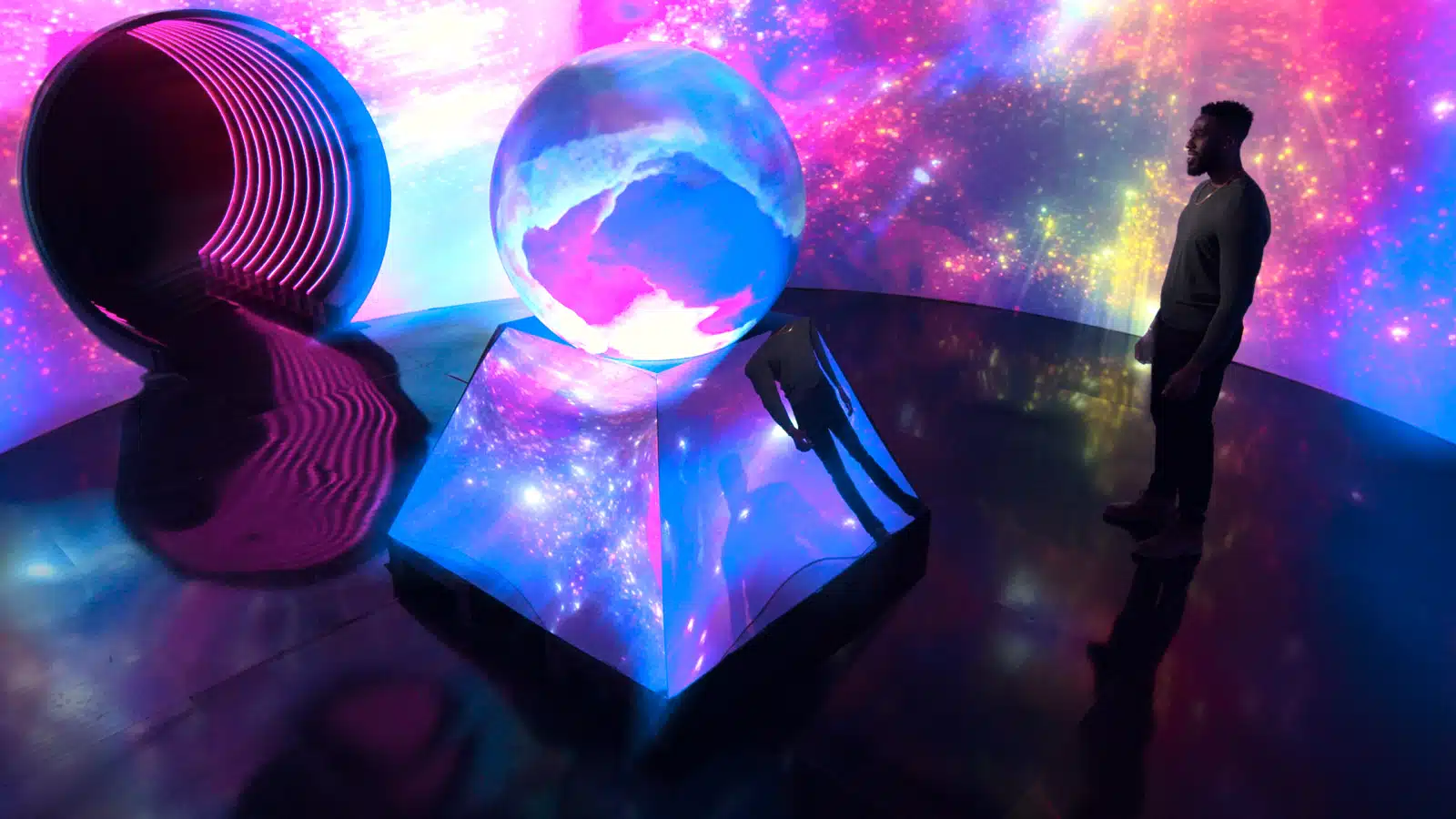Blog: The Science of the Sphere

The Science of the Sphere – Why Spherical Displays Captivate and Engage Audiences by Elaine Van Der Berg, Pufferfish CEO.
Introduction: A Personal Journey into the World of Spherical Displays.
When I first considered joining Pufferfish as CEO, I was struck by the impressive global client base—NASA, Google, BBC, and many others—which clearly demonstrated the value of Pufferfish’s innovative displays. But what sealed the decision for me was seeing a Pufferfish spherical display for the first time. I was captivated by its design and the way it effortlessly pulled me in. It was visually stunning, intuitively engaging, and impossible to ignore—unlike anything I’d ever experienced.
This visceral reaction, I later discovered, was not unique to me. People across industries and cultures—from education and science to corporate environments and visitor attractions—seemed to share the same instinctive draw to these displays. This led me to explore the reasons behind this attraction. Why are spherical displays so universally compelling? My curiosity took me into the realms of psychology, cognitive science, and evolutionary biology, where I learned that our attraction to spherical forms is deeply ingrained in how our minds are wired.


The Science of the Sphere: A Shape Embedded in Our Consciousness
From infancy, humans are naturally drawn to spherical shapes. Babies instinctively focus on rounded objects, finding them comforting and non-threatening. This attraction likely stems from early bonding experiences, such as looking at a caregiver’s face—another rounded shape that instils safety and connection.
As we grow, this preference for spheres persists. Toys, fruits, and everyday objects often take on rounded forms, reinforcing a sense of familiarity and comfort. Psychologists suggest that this affinity is not just cultural but rooted in the brain’s way of processing shapes that feel safe and approachable.
But why does this attraction continue throughout our lives? Celestial bodies—Earth, the moon, the sun—are all spherical, shaped by gravity into their elegant forms. These objects have captured human fascination for millennia, symbolising unity, completeness, and the infinite. Our shared connection to these cosmic shapes explains, in part, why spherical forms continue to captivate us on such a primal level.
The Science of Engagement: Why Spherical Displays Attract and Hold Attention
Our instinctive attraction to spherical shapes is also supported by the Gestalt principles of visual perception, particularly the law of continuity. This principle suggests that the human brain prefers smooth, continuous forms, as they are easier to process than disjointed or angular shapes.
Spherical displays naturally align with this preference, effortlessly attracting more people and drawing their attention as they pass by. The uninterrupted, smooth surface of a sphere offers a visually pleasing experience that engages more of our peripheral vision, creating a sense of immersion.
Unlike flat displays, which limit the viewer’s engagement to a single angle, a sphere invites exploration from all sides, enhancing the experience by enveloping the viewer in the content.
This natural pull results in longer dwell times, as viewers are not only attracted to the shape but are also inclined to stay longer, exploring the content from different perspectives. The more immersive the experience, the more viewers absorb and remember.

The Science of Attraction: The Power of the Sphere in Message Retention
In addition, this deep-rooted affinity for spherical shapes significantly amplifies our attraction to the content displayed. The continuous, unbroken surface of a spherical display offers a unique, immersive visual experience that flat screens cannot replicate. The harmony and completeness of the form resonate deeply with our instincts, creating a near-magnetic pull that draws viewers in.
Spherical displays capitalise on this attraction, transforming passive observation into an active, engaging experience. By aligning with the brain’s preference for smooth, continuous forms, they capture attention and sustain it, allowing for more effective absorption and retention of information. The result is a stronger connection to the material, making it more memorable and impactful. This seamless experience ensures that messages not only resonate deeply but are remembered long after the initial interaction.
The Science of Interaction: Enhancing Memory Retention and Engagement
One of the key benefits of adding touch-reactive interactivity to a spherical display—such as those in many Pufferfish products—is the enhancement of interactive engagement and memory retention. Cognitive Load Theory suggests that reducing the mental effort required to process visual information can improve viewers’ ability to absorb and retain it. Spherical displays, with their natural and continuous format, reduce the cognitive load on the viewer, making it easier for them to process and remember the information.
Additionally, Dual Coding Theory posits that people remember information more easily when it’s presented in both verbal and visual formats. Many Pufferfish clients use our displays to combine visual elements with spoken or written information, creating a multi-sensory experience that leverages this theory for maximum memory retention. Interactive spherical displays engage viewers by encouraging them to explore content through touch, enhancing not only the retention of information but also the overall user experience. This active participation deepens the connection between the viewer and the message, making the experience more personal and memorable.

The Science of Positive Experiences: Delivering Lasting, Meaningful Impressions
Beyond cognitive benefits, spherical displays create positive emotional responses by offering a unique and engaging experience. The tactile and visual interaction with these displays is both novel and familiar, evoking a sense of wonder and curiosity. This kind of positive engagement is essential for creating a lasting connection between the viewer and the content.
The smooth, curved design of the displays also reduces visual fatigue, making them comfortable to engage with for longer periods—whether in a museum, a corporate environment, or an exhibition space. This comfort allows viewers to fully immerse themselves in the experience, making it more enjoyable and impactful.
Spherical displays go beyond the mere transmission of information; they create a space where viewers are drawn in, engage with the content deeply, and leave with positive, lasting memories of their interaction. This means your messages are not just absorbed—they are remembered and appreciated long after the initial encounter.
Conclusion: The Power of the Sphere
Now that I understand the science behind the attraction to spherical displays—their natural ability to draw attention, enhance interaction, improve memory retention, and deliver lasting impressions—it’s no surprise why I was so captivated when I first encountered one. That instinctive pull I felt is rooted in our deep-seated connection to spherical shapes, which resonates across cultures and industries.
By harnessing this inherent appeal and combining it with cutting-edge technology, Pufferfish offers a powerful tool for communication that truly connects with audiences on a fundamental level. Our spherical displays don’t just capture attention—they create memorable, impactful experiences that engage viewers in ways traditional displays cannot. And don’t get me started on why, as human beings, we are becoming more and more comfortable engaging via a screen than face to face—but it’s the way the world is moving. Engaging your audiences through a screen and helping to bridge the gap between screen interaction and human contact, has never been more important.
But don’t just take my word for it—experience the power of the sphere for yourself. Discover how it can transform your messaging and audience interaction. At Pufferfish, we are here to help you Inspire, Educate, and Entertain— across every sphere and every interaction.